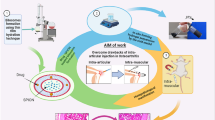Abstract
Purpose
Implanted multi-reservoir arrays improve dosing control relative to osmotic pumps or polymer depots. The limited reservoir volume requires concentrated formulations. This report describes the development of a stable solid phase formulation of leuprolide acetate for chronic in vivo delivery from a multi-reservoir microchip and examines the correlation between in vitro release kinetics and serum pharmacokinetics.
Materials and Methods
Concentrated formulations (>10% w/v) were prepared using small volume processing methods. Drug yield, release kinetics, and formulation stability were evaluated in vitro by HPLC. The correlation between in vitro and in vivo kinetic data was determined for a solid formulation by direct comparison of data sets and using absorption kinetics calculated from the Wagner–Nelson equation.
Results
High yield and the control of release kinetics by altering peptide formulation or reservoir geometry were demonstrated. Lyophilized leuprolide in a soluble solid matrix exhibited reproducible release kinetics and was stable (>95% leuprolide monomer) after 6 months at 37°C. A strong correlation was found between in vitro release kinetics and in vivo absorption by direct comparison of data sets and using the Wagner–Nelson absorption (slopes of 1.01 and 0.91; R2 0.99).
Conclusions
Reproducible releases of a stable solid leuprolide formulation from a multi-reservoir microchip were achieved in vitro. Chronic pulsatile release was subsequently performed in vivo. Comparison of in vitro and in vivo data reveals that pharmacokinetics were controlled by the rate of release from the device.












Similar content being viewed by others
Abbreviations
- DMSO:
-
dimethylsulfoxide
- IVIVC:
-
in vitro–in vivo correlation
- PEG:
-
polyethylene glycol
- PK:
-
pharmacokinetic
- RSD:
-
relative standard deviation
- SD:
-
standard deviation
References
M. Goldberg and I. Gomez-Orellana. Challenges for the oral delivery of macromolecules. Nat. Rev. Drug Discovery 2:289–295 (2003).
R. Langer. Where a pill won’t reach. Sci. Am. 288:50–57 (2003).
J. B. Weitzman. Electronic medical devices: a primer for pathologists. Arch. Pathol. Lab. Med. 127:814–825 (2003).
M. Scavini, et. al. Catheter survival during long-term insulin therapy with an implanted programmable pump. Diabetes Care 20:610–613 (1997).
J. L. Selam, P. Micossi, F. L. Dunn, and D. M. Nathan. Clinical trial of programmable implantable insulin pump for type I diabetes. Diabetes Care 15:877–885 (1992).
M. M. Tan, C. A. Corley, and C. L. Stevenson. Effect of gelation on the chemical stability and conformation of leuprolide. Pharm. Res. 15:1442–1448 (1999).
S. C. Hall, M. M. Tan, J. J. Leonard, and C. L. Stevenson. Characterization and comparison of leuprolide degradation profiles in water and dimethyl sulfoxide. J. Pept. Res. 53:432–441 (1999).
C. L. Stevenson, J. J. Leonard, and S. C. Hall. Effect of peptide concentration and temperature on leuprolide stability in dimethyl sulfoxide. Int. J. Pharm. 191:115–129 (1999).
J. M. Maloney, et al. Electrothermally activated microchips for implantable drug delivery and biosensing. J. Control. Release 109:244–255 (2005).
J. H. Prescott, et al. Chronic, programmed polypeptide delivery from an implanted, multireservoir microchip device. Nat. Biotechnol. 24:437–438 (2006).
V. R. Uppoor. Regulatory perspectives on in vitro (dissolution)/in vivo (bioavailability) correlations. J. Control. Release 72:127–132 (2001).
J. G. Wagner and E. Nelson. Percent absorbed time plots derived from blood level and/or urinary excretion data. J. Pharm. Sci. 52:610–611 (1963).
R. M. Iskakov, A. Kikuchi, and T. Okano. Time-programmed pulsatile release of dextran from calcium-alginate gel beads coated with carboxy-n-propylacrylamide copolymers. J. Control. Release 80:57–68 (2002).
S. Wolf and R. N. Tauber. Silicon Processing for the VLSI Era Vol. 1 Process Technology. Lattice, Sunset Beach, CA, 1986.
H. Okada, et al. Pharmacokinetics of once-a-month injectable microspheres of leuprolide acetate. Pharm. Res. 8:787–791 (1991).
Acknowledgements
We would like to thank all members of the MicroCHIPS team that supported this work. Special recognition is given to David Brancazio, David Lanteigne, Christina Pelta, and Michael Shannon for their contributions.
Author information
Authors and Affiliations
Corresponding author
Rights and permissions
About this article
Cite this article
Prescott, J.H., Krieger, T.J., Lipka, S. et al. Dosage Form Development, in Vitro Release Kinetics, and in Vitro–in Vivo Correlation for Leuprolide Released from an Implantable Multi-reservoir Array. Pharm Res 24, 1252–1261 (2007). https://doi.org/10.1007/s11095-007-9243-2
Received:
Accepted:
Published:
Issue Date:
DOI: https://doi.org/10.1007/s11095-007-9243-2




